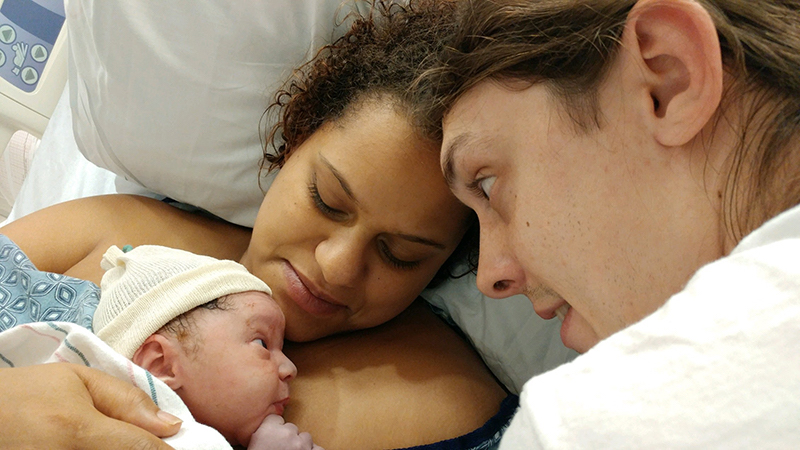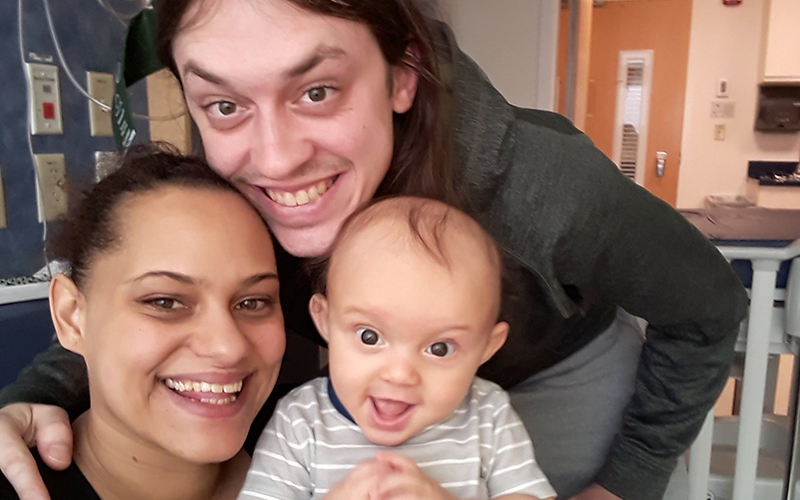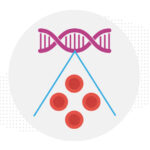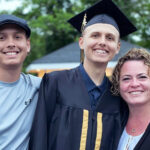Our SCID gene therapy journey

In just 18 months, our son Paul Gallagher has been through more than what most people go through in a lifetime. He was born on Nov. 10, 2017, with a tenacious spirit, yet without an immune system — meaning that the simplest infection was difficult to fight and a common cold was life threatening. His condition is called severe combined immunodeficiency (SCID). It’s a rare genetic illness often called “bubble-boy disease,” because children with SCID have to be kept isolated to protect them from infection.
The typical treatment is a bone marrow transplant, but we opted to enroll Paul in a gene therapy clinical trial, and his progress has been amazing.
A difficult decision: Bone marrow transplant vs. gene therapy
Thirteen weeks into the pregnancy we learned our baby would be born with SCID. We had a lot of time to prepare. Shortly after finding out, the two of us, accompanied by Paul’s grandmother, would have our first appointment with Dr. [Sung Yun] Pai at Dana Farber/Boston Children’s Cancer and Blood Disorders Center. She is largely responsible for how great Paul is doing today.
During our first meeting with Dr. Pai, we talked mainly about the standard treatment for this disease — a bone marrow transplant — and were given a detailed description regarding the treatment process. We also were made aware of a gene therapy clinical trial, but the word “trial” scared us, so at first, we didn’t focus on that option.

These were challenging days. We were worried about our baby. It was hard to comprehend he would have to go through 10 days of intense chemotherapy, which has its own set of risks and side effects.
Although we had tentatively agreed on the bone marrow transplant, we decided to explore the gene therapy option as well.
We knew gene therapy required just two days of chemotherapy, rather than the 10 days required with a bone marrow transplant, so that was something to consider. Dr. Pai was amazing and reassuring. She provided us with guidance and answered all of our questions. In addition, a Facebook group dedicated to children with SCID became a wonderful resource for us.
During the pregnancy, we created a list of comparisons between bone marrow transplant and gene therapy. As our research progressed and our list lengthened, it became increasingly clear we were leaning towards the gene therapy trial. And we decided to go for it.

Along with Paul’s doctors, we came up with a birth plan to have Paul at UMASS Memorial in Worcester, Massachusetts. We brought him home to a sterile environment with a high-powered air filter and a year’s supply of Lysol wipes, donated to us by a charity called Cameron’s Crusaders. Between the air filter and seemingly endless cleaning, miraculously, we kept Paul from getting sick until he was ready for his treatment. Time seemed to stand while we waited.
The gene therapy trial begins
Finally, at 4 months old, we checked in overnight at Boston Children’s Hospital, so they could harvest Paul’s bone marrow. They extracted his stem cells from the bone marrow to reprogram them with the purpose of repairing the faulty gene that caused Paul’s SCID.
We waited a month for them to reprogram the cells and checked back in for the long haul on April 16, 2018. It seemed like forever for this day to arrive. We were nervous, anxious, and scared, but Dr. Pai comforted us, and the wait was worth it.

On April 17 and 18, Paul was given chemotherapy. The following day, it was time for his body to rest. Then, at last, on April 20, Paul received his genetically-modified stem cells. This is called his “life day” — day zero.
We knew we’d be in the hospital for at least a month, and we also knew Paul would experience some type of pain from the chemotherapy, but eventually he was well enough to be discharged on May 20. We breathed a collective sigh of relief. And as of January 2019, Paul is no longer on isolation. His treatment was a huge success. Today, his immune system is normal, and he doesn’t take any medications. He’s a perfect 18-month old boy, always with a smile on his face. He loves cars — anything with wheels — and animals. He’s just a very lovable boy, and we are grateful parents.
Learn more about the Gene Therapy Program.
The evolution of X-linked SCID gene therapy
The history of stem cell gene therapy is forever linked to SCID-X1 or X-linked SCID, the first inherited condition in which gene therapy in hematopoietic stem cells was performed successfully.
The development of gene therapy strategies to treat SCID-X1 began in Europe during the late 90s. Paris and London investigators conducted parallel trials using a retrovirus-derived vector (or vehicle). Although almost all of the boys had improvement of their immune system, one-quarter of the patients developed treatment-related leukemia. The tragedy cast a pall on — and temporarily stalled — gene therapy research, leading to stricter regulations.
In 2008, buoyed by the discovery of safer and more effective vectors, Boston Children’s Hospital researchers requested permission from the government to revive this potentially life-saving treatment for SCID-X1. With the necessary approvals in place, Dana Farber/Boston Children’s collaborated with other gene therapy centers to open an international clinical trial in 2010. Using a self-inactivating gamma retrovirus, designed to eliminate the risk of inadvertently triggering the expression of genes that could lead to leukemia, the study results proved to be a success. Nearly a decade later the patients who received gene therapy remain healthy and SCID-free.
Since those early beginnings, gene therapy has made significant progress. Researchers have turned to lentiviruses, which insert genes into hematopoietic stem cells as retroviruses do, but with even less risk of turning on leukemia genes.
Launched in 2018, the current trial in which Paul Gallagher is enrolled uses a lentivirus as the vector to introduce a functional copy of the of the IL2RG gene. In addition, prior to the stem cell infusion with the corrected gene, the study protocol includes two days of low-dose busulfan (chemotherapy) to optimize immune system recovery.
Paul’s successful outcome, along with others, marks an evolution in gene therapy — a safer way of engineering DNA.
Related Posts :
-

A sickle cell first: Base editing, a new form of gene therapy, leaves Branden feeling ‘more than fine’
Though he doesn’t remember it, Branden Baptiste had his first sickle cell crisis at age 2. Through elementary school, he ...
-

A universal gene therapy for Diamond-Blackfan anemia is poised for clinical testing
Diamond-Blackfan anemia (DBA), first described at Boston Children’s Hospital in 1938, is a rare blood disorder in which the bone ...
-

Cerebral adrenoleukodystrophy: How the Cooksons dodged a devastating disease
Heather Cookson believes that if she hadn’t insisted her son Ricky get a brain MRI to investigate his frequent ...
-

Gene therapy for adrenoleukodystrophy: Studies find both risks and benefits
Cerebral adrenoleukodystrophy (CALD), portrayed in the film Lorenzo’s Oil, is a devastating disorder caused by a mutation on the ...





